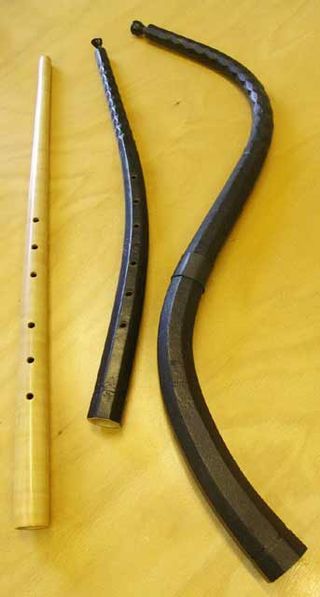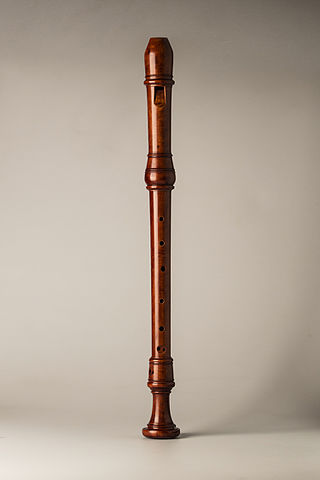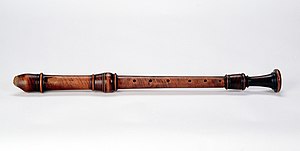
The recorder is a family of woodwind musical instruments in the group known as internal duct flutes: flutes with a whistle mouthpiece, also known as fipple flutes. A recorder can be distinguished from other duct flutes by the presence of a thumb-hole for the upper hand and seven finger-holes: three for the upper hand and four for the lower. It is the most prominent duct flute in the western classical tradition.

The saxophone is a type of single-reed woodwind instrument with a conical body, usually made of brass. As with all single-reed instruments, sound is produced when a reed on a mouthpiece vibrates to produce a sound wave inside the instrument's body. The pitch is controlled by opening and closing holes in the body to change the effective length of the tube. The holes are closed by leather pads attached to keys operated by the player. Saxophones are made in various sizes and are almost always treated as transposing instruments. A person who plays the saxophone is called a saxophonist or saxist.

A clef is a musical symbol used to indicate which notes are represented by the lines and spaces on a musical staff. Placing a clef on a staff assigns a particular pitch to one of the five lines or four spaces, which defines the pitches on the remaining lines and spaces.

A transposing instrument is a musical instrument for which music notation is not written at concert pitch. For example, playing a written middle C on a transposing instrument produces a pitch other than middle C; that sounding pitch identifies the interval of transposition when describing the instrument. Playing a written C on clarinet or soprano saxophone produces a concert B♭, so these are referred to as B♭ instruments. Providing transposed music for these instruments is a convention of musical notation. The instruments do not transpose the music; rather, their music is written at a transposed pitch. Where chords are indicated for improvisation they are also written in the appropriate transposed form.

In organology, the study of musical instruments, many methods of classifying instruments exist. Most methods are specific to a particular cultural group and were developed to serve that culture's musical needs. Culture-based classification methods sometimes break down when applied outside that culture. For example, a classification based on instrument use may fail when applied to another culture that uses the same instrument differently.
Pierre Max Dubois, sometimes given as Pierre-Max Dubois was a French composer of classical music, conductor, and music educator. He was a student of Darius Milhaud, and though not widely popular, was respected. He brought the ideas of Les Six, of which his instructor was a member, into the mid-1900s. This group called for a fresh artistic perspective on music. The music of Dubois is characteristically light hearted with interesting harmonic and melodic textures.
The soprano recorder in C, also known as the descant, is the third-smallest instrument of the modern recorder family and is usually played as the highest voice in four-part ensembles. Since its finger spacing is relatively small, it is often used in music education for children first learning to play an instrument.

A rauschpfeife is a capped conical reed musical instrument of the woodwind family, used in Europe in the 16th and 17th centuries. In common with the crumhorn and cornamuse, it is a wooden double-reed instrument with the reed enclosed in a windcap. The player blows into a slot in the top of the windcap to produce the sound.

Zuffolo (also chiufolo, ciufolo) is an Italian fipple flute. First described in the 14th century, it has a rear thumb-hole, two front finger-holes, and a conical bore. It is approximately 8 cm in length and has a range of over two octaves, from B3 to C6 (Marcuse 1975c). A larger instrument of the same name, with a lowest note of C5 appeared in the early 17th century (Fuller-Maitland, Baines, and Térey-Smith 2001).

The great bass recorder is a member of the recorder family. With the revival of the recorder by Arnold Dolmetsch, who chose Baroque music and the corresponding recorder types as a fixed point, consideration was given to the design of recorder types larger than the bass recorder. The great bass recorder has up to seven keys, which serve to facilitate access to the finger holes. For modern large bass recorders woods like maple or African Bubinga are used. The term usually applies to an instrument with range is c–d2 (g2), but has also been used to describe an instrument descending to B♭ or else to the low bass recorder in F, alternatively known as a contrabass. When "great bass" is used for the instrument in low F, the instruments in C and B♭ are referred to as "quart-bass" and "quint-bass", respectively, because they are a fourth and fifth below the ordinary small bass, or "basset". The prefixes "great" and "contra" refer to the registers from C to B and from ͵C to ͵B, respectively, in Helmholtz pitch notation.

Johann Christian Schickhardt was a German composer and woodwind player.

The mute cornett was an important variant of the treble cornett and it was used in compositions by European composers in the 16th, 17th and 18th centuries. A significant number of mute cornetts have survived and are preserved in various European museums. Modern makers of cornetts produce mute cornetts and the numbers of recordings of music featuring this instrument has increased in recent years.
The sopranino recorder is the second smallest recorder of the modern recorder family, and was the smallest before the 17th century.
The alto recorder in F, also known as a treble (and, historically, as consort flute and common flute) is a member of the recorder family. Up until the 17th century the alto instrument was normally in G4 instead of F4. Its standard range is F4 to G6.

Chiavette is a system of standard combinations of clefs used in polyphonic music of the 16th through 18th centuries, differing from the usual chiavi naturali Typically, these clefs place each staff line a third lower than usual.

Spirits is a solo double album by Keith Jarrett recorded at his home studio over May–June 1985 in New Jersey and released on ECM September the following year, featuring Jarrett performing on various instruments he had on hand: two flutes, three sets of tablas, a shaker, six recorders, his voice, a soprano saxophone, a piano, a guitar, a glockenspiel, a tambourine, a cowbell, and a bağlama.
The garklein recorder in C, also known as the sopranissimo recorder or piccolo recorder, is the smallest size of the recorder family. Its range is C6–A7 (C8). The name garklein is German for "quite small", and is also sometimes used to describe the sopranino in G. Although some modern German makers use the single-word form Garkleinflötlein, this is without historical precedent. Double holes for the two lowest notes (used on the larger recorders to achieve a fully chromatic scale) are uncommon. The instrument is usually notated in the treble clef two octaves lower than its actual sound. The garklein recorder is only about 16 to 18 cm long and is different from larger recorders in that it is usually made in one piece due to its size.

A bass recorder is a wind instrument in F3 that belongs to the family of recorders.

The contrabass recorder is a wind instrument in F2 that belongs to the family of recorders.

The voice flute (also the Italian flauto di voce and the French flûte de voix are found in English-language sources) is a recorder with the lowest note of D4, and is therefore intermediate in size between the alto and tenor recorders.













